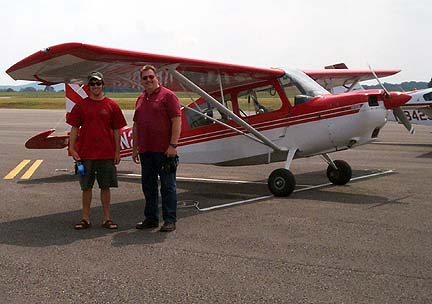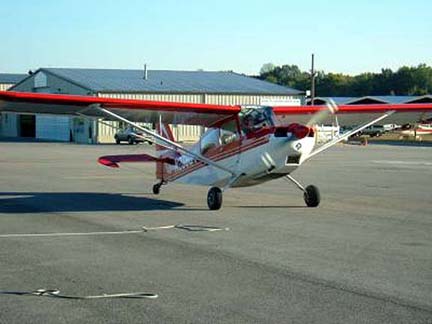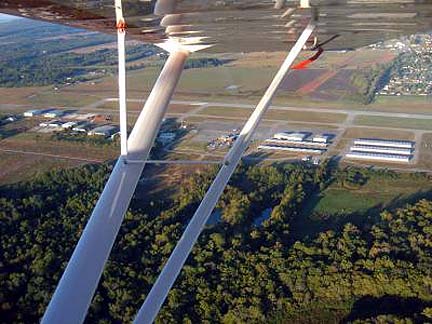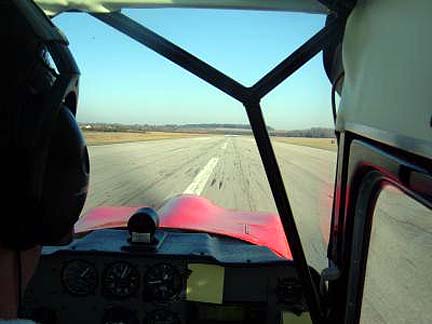
May 24, 2008
Well it's about time to start test flying N57EN. The airplane is ready, but unfortunately I am not. I have not kept up with my flying during the last 5 years and have had very little tailwheel time. If this were a nose wheel airplane, I would probably just get some Cessna 172 time and my flight review from a local instructor. However, since this is a tailwheel airplane, we have a whole different set of skills and flying techniques (more accurately takeoff and landing techniques) to be learned.
After much research, I found a flight school in Alabama that specializes in tailwheel instruction. Its about a 6 hour drive but well worth it to me. Michelle and I drove up to Huntsville , AL on Friday night for a weekend of the most intense, but fun flight training I have ever had.
Here I am with my instructor Aaron Komara and the Citabria that I became
very familiar with over the
weekend:

The Citabria has tandem seating, with the instructor seated in the back and me in the front. Before starting, we spent about 1 hour of ground instruction with Aaron showing me everything with a small wooden model airplane. Since we were also knocking out the flight review, he went over some of the airspace limitations and sectional chart reading, etc. as required by the statutes.
With the ground schooling out of the way and me with a mental picture of
what I was trying to accomplish, it was time to strap on the airplane and
go flying:

We taxied out to the end of the taxiway and did the run-up. After run-up, Aaron told me to taxi out to runway and line up on the centerline. "Now hold the stick all the way back, smoothly add full power and as soon as the throttle is firewalled, push the stick forward and hold it on the centerline with the rudder pedals. When the tail comes up ease the control stick back just a little and keep the tail up off the ground and the nose slightly high. Be fast on the rudder pedals and keep it on the centerline while building speed and then let it fly off the ground" No problem right? WRONG - By the time we left the ground, I was glad that the runway was 100 feet wide because I needed nearly all of that width as the airplane went left and right across it, with me jabbing the rudder pedals back and forth trying to keep it straight. That was truly the ugliest takeoff I have ever done!
I thought to myself "This is not going to be as easy as I thought". Aaron was patient and reassuring and said that it wasn't so bad for a beginner, but I knew it was bad.
We climbed up to 3000 feet and Aaron just had me do some steep turns, slow flight and stalls to get the feel of the airplane. Then we did some coordination exercises (dutch rolls) where you keep the nose on a fixed point on the horizon and roll the wings 30 degrees left and right while holding the nose fixed with rudder pedals. At first I had the nose swinging all over the place but within a minute of two I had it figured out and was able to keep the nose right on the point as I worked the ailerons back and forth banking left 30 degrees and the right 30 degrees.
After that we headed over to a local grass runway (Moontown) that's about
2300 feet long by 80 feet wide to start a series of takeoffs and landings
to a full
stop:

Does the paint scheme look familiar?
The first hour or so was quite ugly as I did a series of 10 or 12 takeoffs and landings. My instructor Aaron has a rule that requires no power approaches to the runway. While downwind, you go to idle when you are abeam the desired touchdown point on the runway and if its done correctly, you should need a little slip to lose altitude on final. The Citabria has no flaps, so slips become almost a necessity.
I actually had a few times where I was way too high and had to start the
slip on base with full right rudder and hold the left wing down and then
while still holding full right rudder, make the turn from base to final using
just the bank angle to make the turn. Then coming down on final with full
right rudder and using the bank angle to stay aligned with the runway. Then,
when I was just about the right height on final, level the wings and neutralize
rudder input, rolling out right on the centerline and lined up perfect and
at the right
airspeed:

Very intense indeed!
Every landing was to a full stop and we would taxi back to the the beginning
of the runway and takeoff again. After about 5 or 6 takeoffs, I had
the takeoff phase nailed, able to get the tailwheel up and dancing on the
rudder pedals to keep the aircraft aligned with the center of the grass strip
with a smooth lift off.

About 2 hours into this beginning exposure of tailwheel takeoffs and landings
we took a break for a water and a restroom break. Of course I was pretty
much drenched in sweat but felt like I was really getting the hang of this
tailwheel thing. Little did I know, that we were about to takeoff and
head over to an asphalt runway, where the learning curve was about to be
steepened:

So off we went back to the asphalt runway where for the next 2.5 hours I slowly built my confidence. Once I had the takeoff portion nailed, Aaron just had me doing touch and goes to save time and get more landings in. By the end of the first day, I had the 3 point landings down, dancing like crazy on the rudder pedals, but keeping it pretty much on the centerline. It took some time to get to a point where I could actually tell the airplane was drifting on final and correct it with bank angle, while keeping the nose pointed at the other other end of the runway to keep it straight for touchdown.
What I learned was, that if you are drifting even a little tiny amount when those mains touch that asphalt, you will be very busy for the next few moments trying to stay on the runway.
That ended the first day. When I got back to the hotel and started to climb the steps up to my room that evening, my legs were sore and quite wobbly. I couldn't believe how much I had used those rudder pedals to the point where I was really worn out. I did several thousand landings in my sleep that night but still got a good night's rest.
The next morning, Aaron told me to get ready for the most intense part of the training. Holy shitake!! It's going to get MORE intense? Today we would do wheel landings and then head over to a local airport with a cross runway, to work on some crosswind takeoffs and landings. He also threw in a couple of simulated engine failures, which were a no brainer since all of my approaches had already been power off.
For the wheel landings, we headed back to the grass runway until Aaron felt that I had it down. The key is to hold it off the runway and just let the mains "kiss" the runway, then push the stick forward enough to hold them on the runway and keep the tail up while bleeding off speed. With the steel spring gear of the Citabria, anything more than a light "kiss" of the mains will result in a bounce back up in the air.
Once I was able to do wheel landings on the grass, we headed back to the
asphalt to do some
there:

Through my headsets I'm hearing "Now keep it on the centerline. Accept
nothing less than the centerline, don't let her drift. Feel it in
your butt, and neutralize it. Keep it straight, keep in straight,
perfect!!!"
After that, we headed over to Guntersville airport which is an asphalt runway
but across the prevailing winds. There was a little crosswind there
and I got the some practice eliminating the drift with bank while holding
the nose on a point, kind of like the dutch rolls we did in the beginning.
It feels a bit weird to have only one main wheel touching the runway,
but I got used to it in short order.
After a lunch break, we headed back to the main airport where we had started. At this point, Aaron asked me to do six landings. Three of the them were 3 point landings and three of them were wheel landings. I nailed each one, nearly perfectly. He asked my how I felt. "Tired" I said. "But how do you feel about your landings" he asked. "Well they could have been a bit better but I think with some practice I've got it nailed".
At that point we taxied back and Aaron made the appropriate endorsement in my logbook for tailwheel flying and another one for my flight review.
Completed: May 25, 2008
Flight time: 7 hours
Landings: Approx. 70 to 75 (I lost count)